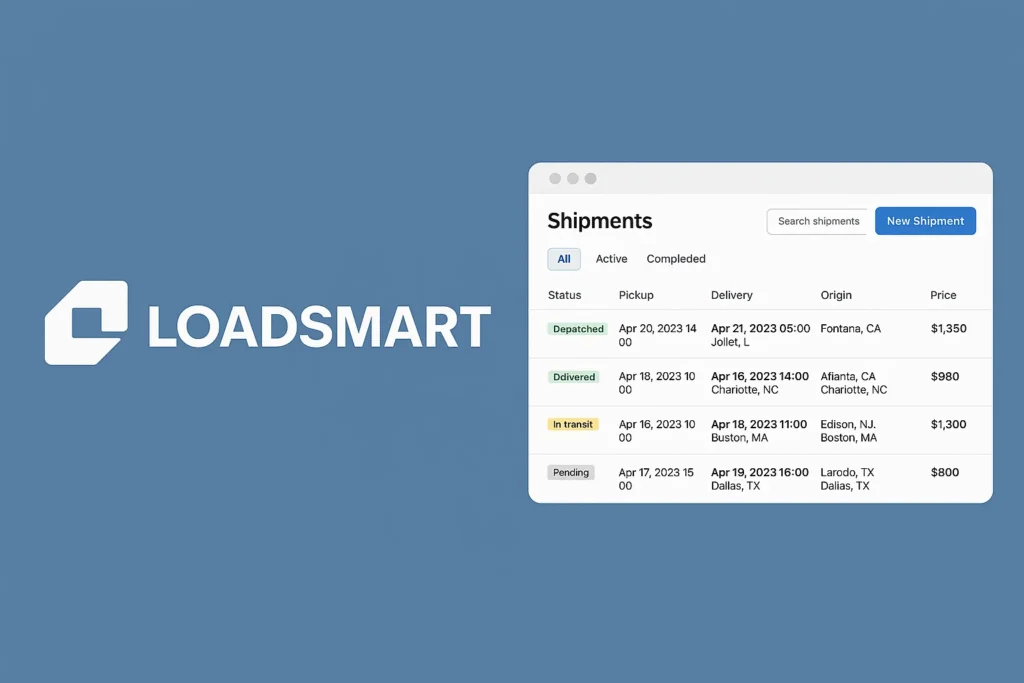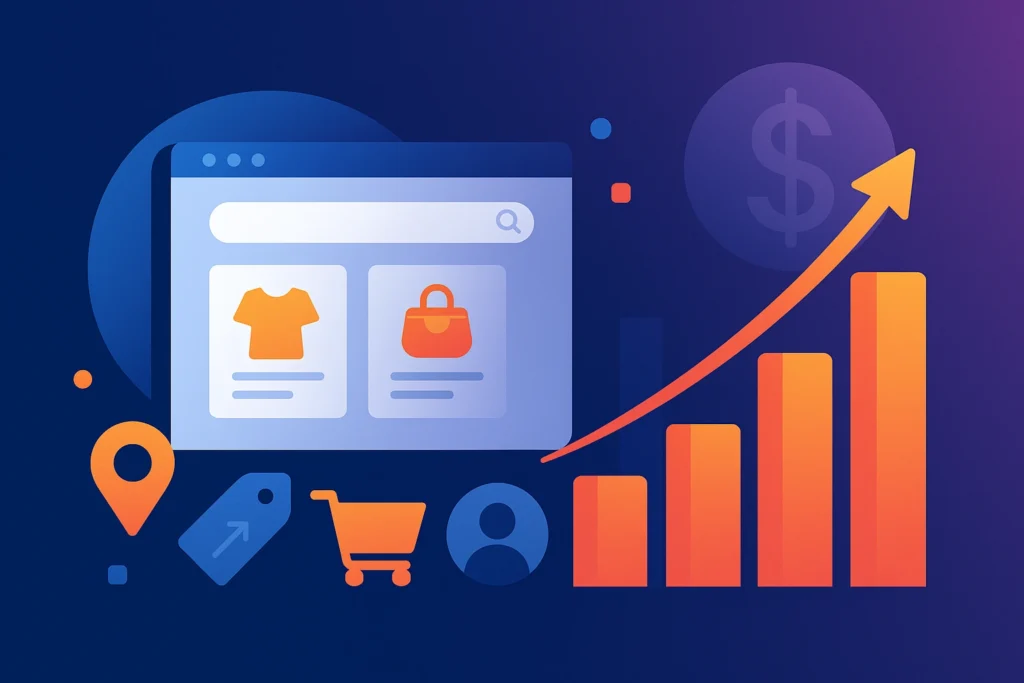The rapid expansion of multi-service apps—often referred to as “super apps”—has transformed the on-demand services landscape. These apps offer a one-stop solution for various services like ride-sharing, food delivery, home services, and much more, all within a single platform. Think of popular apps like Gojek or Grab, which integrate multiple functionalities under one roof.
In this guide, we’ll take a deep dive into building multi-service apps from scratch, offering a step-by-step approach for both beginners and experienced developers. Whether you’re a startup looking to build a Gojek clone or a developer interested in learning about multi-service app development, this guide will cover everything from designing the super app framework to launching the app successfully.
Global Growth Trends in the Multi-Service App Market
The multi-service app market is experiencing rapid global growth, fueled by advancements in technology and the increasing need for convenience in everyday life. Here’s a closer look at the key global growth trends shaping the industry:
1. Rising Popularity in Emerging Markets
- Trend: Countries in the Asia-Pacific region, such as India, Indonesia, and China, are leading the charge in adopting multi-service apps. These markets are witnessing a surge in demand due to rising smartphone penetration, improved internet connectivity, and urbanization.
- Growth Rate: The Asia-Pacific region accounts for over 45% of the global market, with growth projections surpassing 25% CAGR over the next five years.
- Key Drivers: Apps like Gojek, Grab, and WeChat have transformed how users interact with services, from transportation and delivery to financial services, setting the stage for further innovation in the space.
2. Expansion of Super Apps in the Western Markets
- Trend: North America and Europe are relatively newer players in the multi-service app space but are showing considerable growth as super apps begin to penetrate these regions.
- Examples: Companies like Uber and Lyft are expanding their offerings to include services beyond ride-hailing, such as food delivery (Uber Eats), package delivery, and even financial services.
- Growth Rate: While growth in North America and Europe has been slower compared to Asia, the market is expected to grow at a 16% CAGR over the next five years, driven by increasing demand for on-demand services and digital payment solutions.
3. Integration of Financial Services
- Trend: A significant trend in the growth of multi-service apps is the integration of financial services, including digital wallets, bill payments, peer-to-peer money transfers, and microloans.
- Impact: This has not only boosted user retention but has also allowed super apps to generate additional revenue streams. In regions where banking infrastructure is underdeveloped, like Southeast Asia and Africa, these financial integrations are a game-changer.
- Examples: Apps like Paytm in India and WeChat Pay in China are leading the trend, offering full-fledged financial ecosystems that rival traditional banks.
4. Focus on AI and Machine Learning
- Trend: Multi-service apps are increasingly leveraging AI and machine learning to enhance user experience. AI algorithms power personalized service recommendations, dynamic pricing, predictive analytics, and chatbots for customer support.
- Future Prospects: By 2025, AI integration in multi-service apps is expected to increase app efficiency and customer satisfaction by 30%, further driving user engagement and revenue.
5. Growth of Super Apps in Africa and Latin America
- Trend: Regions like Africa and Latin America are beginning to see the rise of homegrown multi-service apps such as Rappi in Latin America and SafeBoda in Africa.
- Growth Rate: The super app market in Latin America is expected to grow at 19% CAGR, driven by the rapid adoption of mobile payments, food delivery, and ride-hailing services.
- Key Drivers: With infrastructure challenges and economic instability, the convenience offered by these all-in-one platforms has led to increased user demand, particularly for low-income and unbanked populations.
6. Rise of Hyper-Localization
- Trend: Multi-service apps are becoming more region-specific, offering localized services to meet the needs of diverse markets. For example, Careem tailors its services to the Middle East by offering regionally relevant features like cash-on-delivery and taxi booking for women-only services.
- Impact: Hyper-localization strategies help companies grow faster by meeting unique regional demands, further boosting user acquisition and engagement.
7. Subscription-Based Models
- Trend: Many multi-service apps are adopting subscription-based models to offer premium services such as priority deliveries, discounted rides, and exclusive offers. This model enhances customer loyalty and generates recurring revenue.
- Examples: Apps like Uber with Uber Pass, and Rappi with Rappi Prime, have successfully rolled out subscription models, providing users with added value and convenience.
- Growth Rate: Subscription-based services within multi-service apps are expected to grow at 20% CAGR, making it one of the fastest-growing revenue streams.
Learn More: Super App Development: Build & Scale Your Multi-Service Platform in 2025
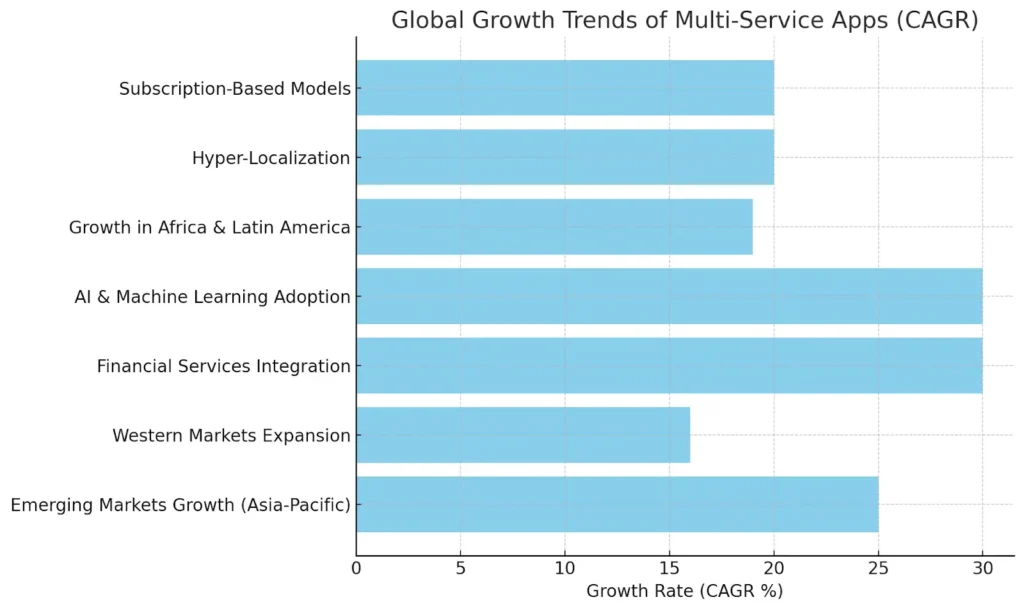
Step-by-Step Breakdown of Building a Multi-Service Apps from Scratch
Developing a multi-service app involves several critical stages, from conceptualization to the final launch. Here’s a comprehensive breakdown of the steps to follow:
1. Defining the App’s Core Concept and Services
- Step: Identify the core services your app will offer. This could range from ride-sharing and food delivery to e-commerce and healthcare.
- Why: Multi-service apps thrive when they solve multiple problems for users in a single platform, so understanding user demand is crucial.
- Pro Tip: Research competitors like Gojek and Grab to understand the range of services that are in demand.
2. Choosing the Right Tech Stack and Super App Framework
- Step: Select a reliable super app framework and a suitable tech stack to support multi-service integration.
- Why: A solid tech stack ensures the app remains scalable and efficient as you add more services. The framework should be flexible enough to integrate third-party services like payment gateways, location services, and real-time tracking.
- Recommended Tech Stack:
- Frontend: React Native, Flutter for cross-platform apps.
- Backend: Node.js, Python (Django/Flask).
- Database: MongoDB, PostgreSQL for scalability.
3. Building the Multi-Service Architecture
- Step: Develop a multi-service architecture where various services like ride-hailing, on-demand delivery, and e-commerce are housed under a single application. Utilize microservices architecture for better management of different services.
- Why: This structure allows each service to run independently, ensuring scalability and smooth performance.
- Example: A Gojek clone integrates over 20 services, making microservices essential for performance and ease of updating.
4. Designing the User Interface (UI) and User Experience (UX)
- Step: Focus on intuitive UI/UX to offer seamless navigation between different services. The design should provide an easy-to-understand interface for users who might not be tech-savvy.
- Why: An engaging and functional UI/UX can significantly improve user retention. Ensuring that users can quickly switch between services (like from ride-hailing to ordering groceries) enhances user engagement.
5. Developing Smart Features and Functionalities
- Step: Implement critical features such as real-time tracking, in-app payments, service scheduling, and a robust support system (e.g., in-app chat). Additionally, integrate a wallet to handle all transactions securely.
- Why: These features make the app more appealing by providing convenience and security, essential for retaining users.
- Pro Tip: Multi-payment integration with services like PayPal, Stripe, and local options (like UPI in India) enhances user accessibility.
6. Testing the App for Bugs and Usability
- Step: Rigorous testing is essential before the launch to ensure that all services work smoothly and there are no issues with payment gateways, notifications, or data synchronization.
- Why: Quality assurance is crucial to prevent glitches that could drive users away from the app early on. Run alpha and beta tests to gather real user feedback before scaling.
7. Launching and Scaling the Multi-Service App
- Step: Plan the app launch in a phased manner, initially releasing core services and gradually adding more based on user feedback.
- Why: Phased launches allow for better monitoring and user experience optimization, preventing crashes from sudden high demand.
- Pro Tip: Use robust marketing strategies, including referral programs and influencer marketing, to gain early traction.
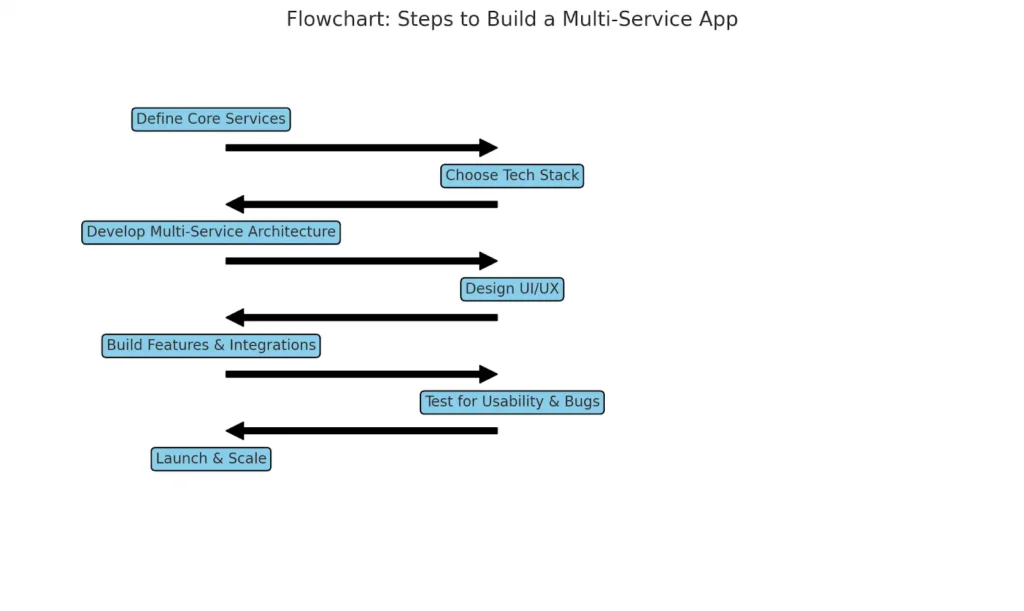
Learn more about Super App Development: Build & Scale Your Multi-Service Platform.
Comparison of Multi-Service App Frameworks
Choosing the right framework is crucial for the success of your multi-service app. Here’s a comparison table of some popular multi-service app frameworks used for building apps like Gojek:
| Framework | Best For | Features | Pros | Cons |
| Flutter | Cross-platform apps (iOS, Android) | Single codebase, fast development, beautiful UI, high performance | Hot reload, great for both Android and iOS, strong community | Limited native support for some complex features |
| React Native | Cross-platform with native feel | Strong performance, modular architecture, native APIs | Large developer community, great for MVPs, fast iterations | Native performance may lag compared to real native apps |
| Ionic | Web apps & hybrid apps | Built on Angular, supports web and mobile apps | Easy to use, supports many plugins, good for quick launches | Performance can suffer for highly complex apps |
| Node.js + Express | Backend services & APIs | Great for building microservices architecture, real-time apps | Asynchronous, scalable, lightweight, fast for APIs | Requires more configuration for frontend support |
| Laravel + Vue.js | Backend-heavy apps with real-time features | Elegant syntax, built-in security features, modular structure | Excellent documentation, flexible, full-stack support | Slightly steep learning curve for beginners |
Which Framework is Best for Your Multi-Service App?
- Flutter and React Native are excellent choices if you are building a cross-platform app and need a fast time to market with a single codebase for both iOS and Android.
- Ionic is suitable for businesses looking for a quick hybrid app launch that works across devices, but it’s better for apps with less complexity.
- Node.js + Express and Laravel + Vue.js offer strong backend capabilities, making them ideal for apps with heavy real-time functionalities like ride-hailing or on-demand services.
Choosing the right framework depends on your specific use case, performance needs, and the complexity of services you plan to integrate.
Cost of Developing a Multi-Service App
| Cost Factor | Global Estimated Cost (USD) |
| Platform Setup & Architecture | $10,000 – $30,000 |
| UI/UX Design | $5,000 – $15,000 |
| Core Features & Integrations | $20,000 – $50,000 |
| Backend Development | $15,000 – $40,000 |
| Testing & Quality Assurance | $5,000 – $10,000 |
| Deployment & Maintenance | $3,000 – $10,000 (Initial) |
| Total Global Cost Estimate | $58,000 – $155,000 |
At Miracuves Solutions, multi-service app development prices start from just $1899, offering a more affordable solution compared to the global average development costs, without compromising on quality.
See your multi service app development in action!
Our experts will guide you through every step.
Revenue Model for Multi-Service Apps
A multi-service app like Gojek offers several opportunities for monetization, thanks to the diversity of services integrated into the platform. Below are some common revenue models that multi-service apps can adopt:
1. Commission-Based Model
- How It Works: The app takes a commission from each transaction carried out on the platform. For instance, with ride-hailing or food delivery services, a small percentage is charged to the service provider (e.g., drivers or restaurants) for using the platform.
- Example: Gojek and Grab charge a commission on every ride, delivery, or service booking made through their platform.
- Pros: Consistent revenue stream, scalable as the number of transactions grows.
- Cons: Competitive pricing might require lowering commission rates to attract more service providers.
2. Subscription Model
- How It Works: Offer a subscription service for users or service providers. Users can pay a monthly or yearly fee for premium features, like faster delivery, priority service, or exclusive deals. Service providers can subscribe to a premium account for better visibility and reduced commission fees.
- Example: Uber and Deliveroo offer subscription plans to users for free delivery or priority services.
- Pros: Recurring revenue, predictable cash flow.
- Cons: Users may not see immediate value in subscriptions unless they use the services frequently.
3. Advertising
- How It Works: Monetize app traffic by selling advertising space within the app. Ads can be displayed to users based on their location, preferences, or search history. Offering targeted advertising can generate significant revenue.
- Example: Apps like UberEats offer restaurants featured listings or ad placements for better visibility.
- Pros: High-profit margins, especially if you have a large user base.
- Cons: Ads can potentially disrupt the user experience if not well integrated.
4. Service Fees
- How It Works: Charge a flat service fee for each transaction made on the platform. For instance, users might be charged a small fee for each ride or food order placed.
- Example: Food delivery apps often charge customers a service fee in addition to delivery fees.
- Pros: Additional revenue per transaction, users are generally willing to pay for convenience.
- Cons: Service fees might discourage users if they feel the total cost becomes too high.
5. Surge Pricing
- How It Works: Implement surge pricing during peak demand times. When the demand for services (e.g., ride-hailing or delivery) exceeds supply, prices increase dynamically. Surge pricing can significantly boost revenue during busy times.
- Example: Ride-hailing apps like Uber implement surge pricing during rush hours or bad weather.
- Pros: Maximizes revenue during high-demand periods, incentivizes more service providers to come online.
- Cons: Can lead to negative user sentiment if prices get too high during critical times.
6. In-App Purchases and Add-Ons
- How It Works: Offer additional paid features or services within the app, such as insurance options for deliveries or enhanced safety features for ride-hailing.
- Example: Food delivery apps sometimes offer meal insurance, where users pay extra to ensure a refund if the order is incorrect.
- Pros: Offers flexibility for users to enhance their experience, adds an additional revenue stream.
- Cons: Requires careful balance to avoid overloading users with add-ons.
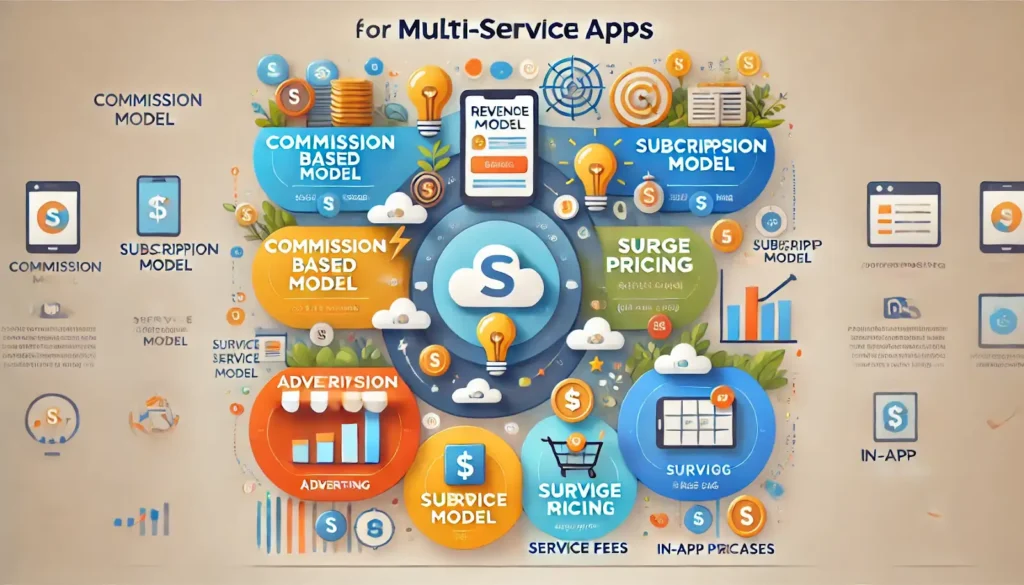
What Features Should Be Present in a Multi-Service App?
A multi-service app must include a combination of essential features that provide a seamless and efficient user experience while supporting a wide variety of services. Below are the key features to consider:
1. User Profiles and Account Management
- Feature: Allow users to create and manage their profiles with personal details, service preferences, and payment methods.
- Why It’s Important: Personalization enhances user experience and ensures quick access to services.
2. Multi-Service Dashboard
- Feature: A centralized dashboard where users can access all available services (e.g., ride-hailing, food delivery, e-commerce).
- Why It’s Important: Simplifies navigation by offering all services in one place, increasing convenience.
3. Real-Time Tracking
- Feature: Real-time GPS tracking for services such as deliveries and ride-sharing.
- Why It’s Important: Users expect to track the status of their orders or rides in real-time to plan accordingly.
4. In-App Payments
- Feature: Integration of multiple payment options, including credit/debit cards, wallets, UPI, and PayPal.
- Why It’s Important: Offering various payment methods ensures accessibility and ease of transaction for users across different regions.
5. Scheduling and Booking
- Feature: Allow users to schedule services in advance, such as booking a ride for a later time or scheduling a home cleaning service.
- Why It’s Important: Provides flexibility and convenience, appealing to users who prefer to plan ahead.
6. Push Notifications
- Feature: Send real-time alerts and updates regarding service status, special offers, and new features.
- Why It’s Important: Keeps users engaged and informed about their services and promotions, improving retention.
7. Service Reviews and Ratings
- Feature: Enable users to rate and review the services they’ve used, such as rides, food orders, or home services.
- Why It’s Important: Builds trust by showing potential users the experiences of others, while also helping service providers improve.
8. In-App Support and Chat
- Feature: Provide customer support via in-app chat or phone for quick issue resolution.
- Why It’s Important: Ensures users receive assistance for any issues, increasing satisfaction and trust.
9. Wallet Integration and Referral Bonuses
- Feature: Include a digital wallet where users can store funds and offer referral bonuses for bringing in new users.
- Why It’s Important: Boosts user engagement and offers incentives for recommending the app to others.
10. Multi-Language and Multi-Currency Support
- Feature: Support multiple languages and currencies to cater to global or regional audiences.
- Why It’s Important: Necessary for apps targeting multiple regions, ensuring accessibility and convenience for a wider audience.
11. Admin Panel for Service Providers
- Feature: Allow service providers to manage their services, orders, and revenue through an intuitive dashboard.
- Why It’s Important: Helps providers efficiently manage operations and deliver services on time, ensuring a smooth user experience.
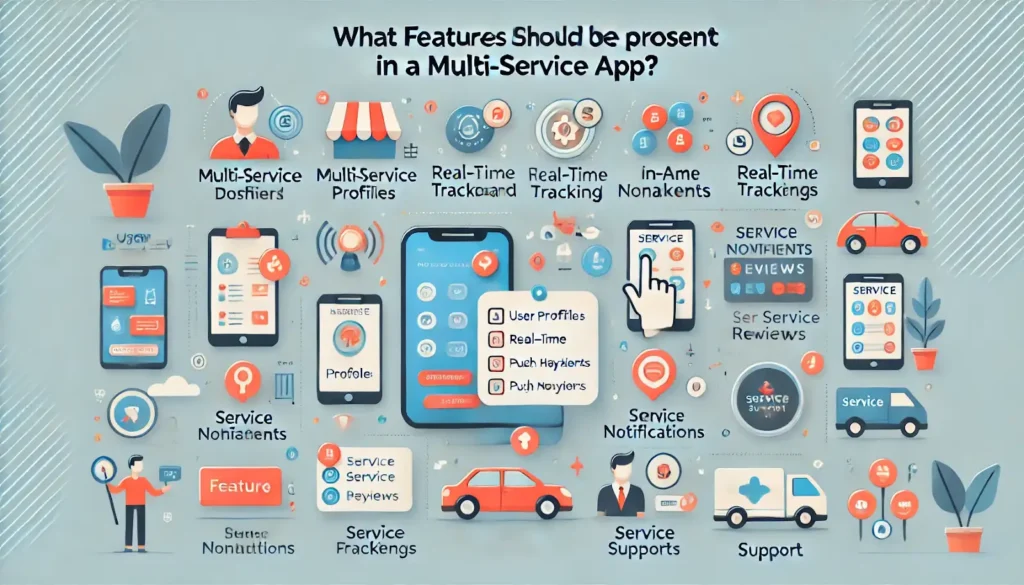
What Do Multi-Service Apps Offer?
Multi-service apps offer a variety of services across multiple categories, all accessible through a single platform. Here’s what they typically include:
1. On-Demand Services
- Offer: Ride-hailing (e.g., taxis, bikes), food delivery, grocery delivery, and courier services.
- Why It’s Important: These services cater to immediate user needs, such as transportation and daily essentials, making life more convenient.
2. Home Services
- Offer: Plumbing, cleaning, electrician services, home repairs, and beauty services.
- Why It’s Important: Helps users quickly find and book reliable professionals for household tasks, saving them time and effort.
3. Financial Services
- Offer: Digital wallets, mobile banking, and payment processing.
- Why It’s Important: Provides easy access to financial transactions, bill payments, and money transfers, enhancing the user experience.
4. Healthcare and Wellness Services
- Offer: Doctor consultations, telemedicine, pharmacy delivery, fitness services, and on-demand wellness professionals (e.g., yoga instructors).
- Why It’s Important: Offers convenience for users to manage their health, book appointments, or receive medications without leaving their homes.
5. E-Commerce and Shopping
- Offer: Retail shopping, marketplace integration, and product delivery.
- Why It’s Important: Allows users to purchase products and services online and have them delivered quickly, competing with dedicated e-commerce platforms.
6. Logistics and Delivery
- Offer: Package delivery, courier services, and transportation of goods.
- Why It’s Important: Provides both personal and business users with logistics support for sending and receiving packages.
7. Entertainment and Media
- Offer: Streaming services, event bookings, and ticket sales for concerts, movies, and shows.
- Why It’s Important: Offers users entertainment options within the same app where they manage other aspects of their life, enhancing convenience.
Well-known Examples of Multi-service Apps
1. Gojek (Indonesia)
- Services Offered: Gojek is the gold standard for multi-service apps, offering over 20 services including ride-hailing, food delivery (GoFood), grocery shopping (GoMart), courier services (GoSend), beauty services, home cleaning, and more.
- Unique Features: Gojek integrates real-time tracking, in-app payments, and a wallet system, making it a one-stop solution for millions of users in Southeast Asia.
- Why It’s Popular: Gojek provides convenience for users by aggregating multiple services into one app, reducing the need for separate applications for different tasks.
2. Grab (Southeast Asia)
- Services Offered: Grab started as a ride-hailing app and has since expanded into food delivery (GrabFood), grocery delivery (GrabMart), courier services, digital payments (GrabPay), and even financial services like loans and insurance.
- Unique Features: It offers subscription plans for frequent users and partners with various industries to expand its service portfolio, making it a super app for Southeast Asia.
- Why It’s Popular: Grab’s user-friendly interface and extensive service offerings have made it a dominant player in the region, simplifying life for both consumers and service providers.
3. Careem (Middle East, North Africa, Pakistan)
- Services Offered: Careem offers ride-hailing, food delivery, grocery delivery, bike rentals, parcel delivery, and payment services via its wallet system.
- Unique Features: Careem focuses on providing localized services for the Middle Eastern market and includes a reward system for frequent users.
- Why It’s Popular: Careem’s integration of transport, logistics, and financial services in one platform makes it highly useful in regions where these services are fragmented.
4. WeChat (China)
- Services Offered: While known primarily as a messaging app, WeChat also offers ride-hailing, food delivery, financial services, e-commerce, hotel bookings, and digital payments (WeChat Pay).
- Unique Features: WeChat integrates mini-programs within the app, allowing users to access third-party services without leaving the platform.
- Why It’s Popular: With over a billion active users, WeChat is the ultimate super app in China, handling everything from daily communication to financial transactions and service bookings.
5. Rappi (Latin America)
- Services Offered: Rappi offers food delivery, grocery shopping, pharmacy orders, courier services, and even cash withdrawal services where couriers deliver cash to users.
- Unique Features: Rappi is expanding into financial services, offering RappiPay for payments, and has a subscription model (Rappi Prime) for users who want free delivery and exclusive benefits.
- Why It’s Popular: Rappi’s diverse service offerings and innovative features, such as cash delivery and financial services, make it a dominant super app in Latin America.
6. Paytm (India)
- Services Offered: Originally launched as a mobile wallet, Paytm has expanded into bill payments, ride-hailing, financial services, e-commerce, movie ticket bookings, and more.
- Unique Features: Paytm’s financial services, including loans and insurance, set it apart from other apps, making it a leading super app in India.
- Why It’s Popular: Paytm’s wide variety of services, strong brand trust, and integration into India’s payment systems have made it one of the top super apps in the country.
These apps showcase how a multi-service approach can simplify users’ lives by offering everything from transportation and food delivery to financial services in a single platform, making them highly convenient and essential in their respective regions.
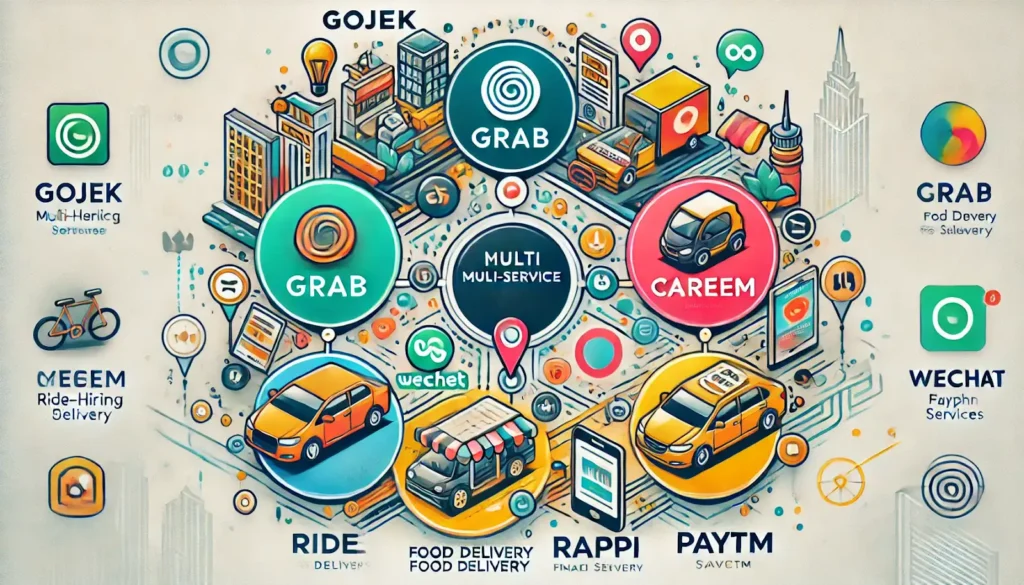
Final Thoughts
Building a multi-service app is not just about offering a variety of services—it’s about delivering convenience, innovation, and scalability to users. Whether you’re a business looking to enter this space or a developer interested in creating the next Gojek or Grab, the steps and strategies outlined in this guide provide a clear pathway.
By focusing on a strong tech stack, scalable architecture, and choosing the right revenue model, your multi-service app can thrive in today’s competitive market. Companies like Miracuves Solutions offer cost-effective development options, with prices starting at $1899, making it easier than ever to enter the super app industry.
Now’s the time to take advantage of the growing demand for multi-service apps and build a platform that stands out.
Want to build a powerful multi-service app?
Let’s define your vision, tech stack, and features for success.
FAQ
What is a multi-service app and why should you build one?
A multi-service app is a single platform offering multiple services like food delivery, ride-hailing, and e-commerce. It provides users with convenience and a streamlined experience. Building a multi-service app can help businesses capture diverse markets, increase revenue streams, and boost customer retention through a single, cohesive solution.
How do you start building a multi-service app from scratch?
To build a multi-service app from scratch, you need to follow these steps: identify your target market, decide on essential features, choose a tech stack, and plan for UI/UX design. Partner with an experienced app development team to ensure scalability, performance, and security. Testing and continuous updates are key to successful long-term operation.
What are the essential features of a successful multi-service app?
A successful multi-service app must include essential features like user profiles, service listings, in-app payments, real-time tracking, notifications, and customer support. Additionally, integrating AI for personalized recommendations and multi-language support can enhance the user experience, making your app stand out in the competitive market.






